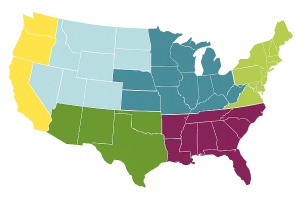All About Red Hot Poker
Posted By American Meadows Content Team on Mar 27, 2017 · Revised on Oct 3, 2025

Knowing your location helps us recommend plants that will thrive in your climate, based on your Growing Zone.
Posted By American Meadows Content Team on Mar 27, 2017 · Revised on Oct 3, 2025

If you're looking for a stunning plant to add an accent to your sunny flower border, consider the Red Hot Poker plant. There are more than 70 species of Kniphofia or the Torch Lily from South Africa, but few have made it into the commercial trade.
This plant once was popular in England and Europe, but during the second World War, many were replaced with edible plants in an effort to feed the people. But the interest in Red Hot Poker plants has returned, as gardeners further their search for showy, unusual, low-maintenance plants.
While the Red Hot Poker plant may look like it belongs in the deserts of Southern California, it actually is quite hardy and needs more water than you'd think. Red Hot Pokers are hardy in USDA zones 6 to 9. In cold areas, if you can grow an Adam's needle (Yucca filimentosa), you probably can grow Red Hot Poker. The key, though, is water drainage.
While the crown and roots are hardy, they cannot withstand sitting in soggy soils, especially in winter and early spring.
Planting in a sandy loam soil or in well-drained raised beds amended heavily with compost will be the best bet to bring your perennial Red Hot Poker back each spring.
Beside the exotic look, what attracts many gardeners to red hot poker plants is the ease of growing.
Red hot pokers have few disease problems other than the crown rotting in wet soils. Deer and rabbits seem to avoid the plants and few insect pests bother them.

The size of the plant ranges from the 5 foot tall 'Royal Standard' to the 1 to 2 foot tall 'Little Maid'. While the traditional and most common red hot poker variety has orange or red flowers turning to yellow as it ages, there are other color choices. 'Springtime' has coral and yellow flowers. 'Goldmine' has amber colored blooms. 'Tawny King' has cream and apricot colored flowers. 'Bees Lemon' has yellow and green flowers.
The flowers are actually clusters of small, tube-shaped blooms that hummingbirds, butterflies and bees love. Most varieties start blooming in early to midsummer and continue into fall, especially if you deadhead (remove) spent blossoms. The contrast of the tall, torch-like stalks with colorful flowers on the end with the aloe-like leaves is outstanding. The leaves remain evergreen in warmer climates, but are deciduous in colder regions.
Since Red Hot Poker has such as long bloom period, and individual flowers can last up to 18 days, this plant should be featured prominently in your garden. Plant red hot pokers in front of an evergreen hedge or along the edge of an evergreen tree to show off the colorful flowers. Plant them in clumps to have a greater visual effect instead of one individual plant. You can also plant Red Hot Pokers near a pond or wetland area, as long as they're planted in a well-drained soil.

Plant other perennials that thrive in the full sun, well-drained soil conditions as companions. In midsummer, team Red Hot Pokers up with salvia, echinacea, rudbeckia and artemisia. For later in the summer and fall, as your Red Hot Poker continues to flower, plan to have Russian sage, Joe-Pye weed and Verbena bonariensis blooming close by for a dazzling, colorful effect. The blue and purple colored flowers, in particular, contrast well with the traditional yellow, orange and red of the Red Hot Pokers.
Asters and sedums can be used as a fall color complement, and dahlias and cannas are surely great companions, too. Consider dahlia and canna varieties whose flowers and foliage complement the color of your Red Hot Poker plant. You also can never go wrong pairing Red Hot Pokers with ornamental grasses. The grassy nature of both plants makes them look related, but the flowers and grass seed heads contrast beautifully, adding color and architecture to the garden.
Red Hot Pokers also make excellent cut flowers in flower arrangements. Cut them in the morning when in full bloom. They're very dramatic flowers, so pair them with unassuming grasses, ferns, and hostas. Use Red Hot Poker to add height to the vase, filling in the sides and bottom of the arrangement with yarrows, daisies, lilies, and caladiums.

About the Author: Charlie Nardozzi is a nationally recognized garden speaker, author, consultant, radio and TV show host. He delights in making gardening information simple, easy, fun and accessible to everyone. Visit his website, GardeningwithCharlie.com for how-to gardening information, and for more about Charlie.
To learn more about the plants we sell and how to grow them in your garden beds and patio containers, sign up for our inspiring emails.